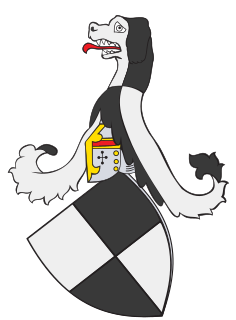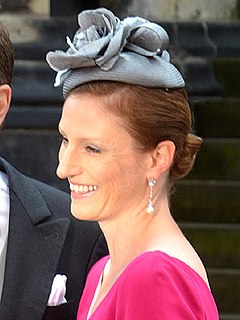
The House of Hohenzollern is a German former royal dynasty whose members were variously princes, electors, kings and emperors of Hohenzollern, Brandenburg, Prussia, the German Empire, and Romania. The family arose in the area around the town of Hechingen in Swabia during the 11th century and took their name from Hohenzollern Castle. The first ancestors of the Hohenzollerns were mentioned in 1061.
Morganatic marriage, sometimes called a left-handed marriage, is a marriage between people of unequal social rank, which in the context of royalty prevents the husband's titles and privileges being passed on to the wife and/or any children born of the marriage.

Duke Frederick VIII was the German pretender to the throne of Schleswig-Holstein from 1863, although in reality Prussia took overlordship and real administrative power.

Georg Friedrich Ferdinand, Prince of Prussia is a German businessman who is the current head of the Prussian branch of the House of Hohenzollern, the former ruling dynasty of the German Empire and of the Kingdom of Prussia. He is the great-great-grandson and historic heir of Wilhelm II, the last German Emperor and King of Prussia, who abdicated and went into exile upon Germany's defeat in World War I in 1918.

Louis Ferdinand Victor Eduard Adalbert Michael Hubertus, Prince of Prussia was a member of the royal House of Hohenzollern and the pretender for a half-century to the abolished German throne. He was also noteworthy as a businessman and a patron of the arts.

The Order of the Black Eagle was the highest order of chivalry in the Kingdom of Prussia. The order was founded on 17 January 1701 by Elector Friedrich III of Brandenburg. In his Dutch exile after World War I, deposed Emperor Wilhelm II continued to award the order to his family. He made his second wife, Princess Hermine Reuss of Greiz, a Lady in the Order of the Black Eagle.
The German nobility and royalty were status groups which until 1919 enjoyed certain privileges relative to other people under the laws and customs in the German-speaking area.
Prince Louis Ferdinand Oskar Christian of Prussia, also called Louis Ferdinand II or Louis Ferdinand Jr., nicknamed "Lulu", was a member of the House of Hohenzollern and the fifth of seven children of Prince Louis Ferdinand of Prussia and his wife, Grand Duchess Kira of Russia. He was the son and designated heir of the pretender to the German throne but died as a result of an accident while performing military service.

The succession order to the throne of the Romanian monarchy, abolished since 1947, was regulated by the monarchical constitution of 1938, suspended by the Royal Law Decree no. 3052 of September 1940 and the 1884 Law of the Romanian Royal House Rules enacted pursuant to the 1866 Constitution of Romania which had confirmed the enthronement of Prince Karl (Carol) of Hohenzollern-Sigmaringen. The 1938 Constitution stipulated Salic law, according to which the throne was hereditary in King Carol I's legitimate descent and, if his male issue failed, in the descent of his brothers of the Sigmaringen princely branch of the House of Hohenzollern, according to agnatic primogeniture and to the perpetual exclusion of females and their descendants. The last monarch to reign in Romania was King Michael I, who was born in 1921, abdicated his throne on 30 December 1947 under coercion, and went into exile in Switzerland. He died on 5 December 2017 in Aubonne, Switzerland.
Saxe-Gessaphe is the name of a family descended in the female line from former kings of Saxony, a member of which was recognized by a childless pretender to that throne as eventual heir to the deposed dynasty's rights. The claim is contested by an agnatic descendant of the former royal house, and both claims are clouded by conflicting interpretations of the dynastic laws which governed the succession to the defunct throne of Saxony, and by familial dispute.

Grand Duchess Kira Kirillovna of Russia was the second daughter of Grand Duke Kirill Vladimirovich of Russia and Princess Victoria Melita of Saxe-Coburg and Gotha. She married the head of the German Imperial House, Prince Louis Ferdinand of Prussia.

Constantin, Prince of Hohenzollern-Hechingen, was the last Prince of Hohenzollern-Hechingen. Constantine was the only child of Frederick, Prince of Hohenzollern-Hechingen and his wife, Princess Pauline of Courland, the daughter of the last Duke of Courland, Peter von Biron.

Prince Joachim Viktor Wilhelm Leopold Friedrich Sigismund of Prussia was a German World War I fighter pilot and member of the House of Hohenzollern. He was the son of Prince Friedrich Leopold of Prussia and Princess Louise Sophie of Schleswig-Holstein-Sonderburg-Augustenburg, married in 1916.
Duke Friedrich August of Oldenburg was a member of the House of Holstein-Gottorp. He is a son of Nikolaus, Hereditary Grand Duke of Oldenburg and Princess Helena of Waldeck and Pyrmont.

Sophie Johanna Maria, Princess of Prussia is the wife of Georg Friedrich, Prince of Prussia, head of the House of Hohenzollern.
Philipp Christoph Friedrich, Prince of Hohenzollern-Hechingen was a German nobleman. He was the third prince of Hohenzollern-Hechingen.

The Monarchy of Germany was the system of government in which a hereditary monarch was the sovereign of the German Empire from 1871 to 1918.

Irina Mikhailovna Raievskya, was a Russian and German noble. She was Duchess of Mecklenburg by her marriage to her second husband, George, Duke of Mecklenburg, who was the head of the House of Mecklenburg-Strelitz from 1934 until his death in 1963. Irina is the great-grandmother of Sophie, Princess of Prussia, wife of Georg Friedrich, Prince of Prussia, current head of the House of Hohenzollern.

Prince Michael of Prussia was a member of the Hohenzollern dynasty which ruled Germany until the end of World War I. His great-grandfather William II was the German Emperor and King of Prussia until 1918. Although "Kaiser Wilhelm" died in exile and his family was stripped of much of its wealth and recognition of its rank and titles by the German Republic, he spent nearly all of his life in Germany.